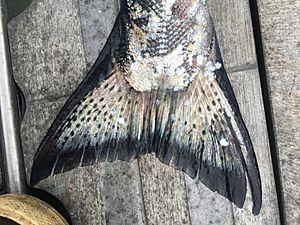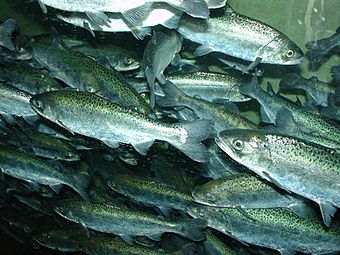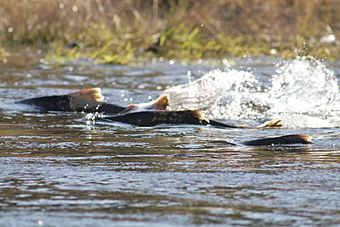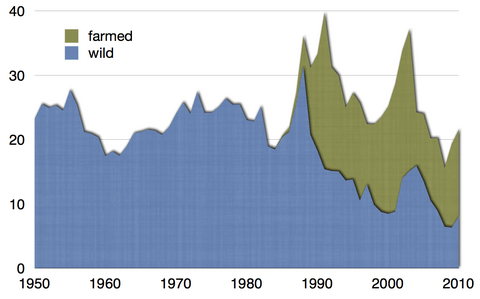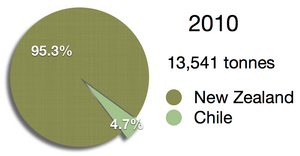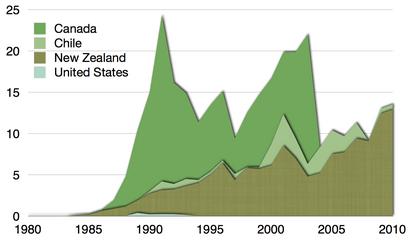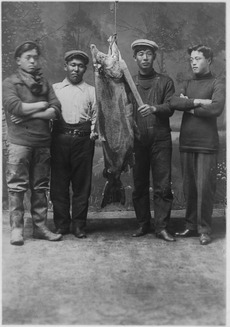Chinook salmon facts for kids
Quick facts for kids Chinook salmon |
|
|---|---|
 |
|
| Scientific classification | |
| Genus: |
Oncorhynchus
|
| Species: |
tshawytscha
|
The Chinook salmon (Oncorhynchus tshawytscha) is the biggest type of Pacific salmon. It's also known as king salmon, spring salmon, or Tyee salmon. Its name comes from the Chinookan peoples.
Chinook salmon are special fish that live in both fresh and salt water. They are born in rivers, travel to the Pacific Ocean to grow, and then return to their home rivers to lay eggs. You can find them along the western coast of North America, from California to Alaska, and in some rivers in northern Japan and Siberia. People have also brought them to other places like New Zealand and the Great Lakes in North America, where they are doing well.
These salmon are very popular for fishing because they are large and put up a good fight. Their meat is also very healthy to eat, full of good fats called omega-3 fatty acids. While some groups of Chinook salmon are in danger, many others are healthy.
Contents
Where Chinook Salmon Live
Natural Homes of Chinook Salmon
Long ago, Chinook salmon lived all along the western coast of North America, from California up to Alaska. They were also found in rivers in northern Japan and parts of Siberia. However, their numbers have gone down in many areas, sometimes by as much as 40 percent. Dams and changes to their river homes have stopped them from reaching many places they used to live, like some areas in California and the Columbia River basin.
New Homes for Chinook Salmon
In 1967, Chinook salmon were brought to Lake Michigan and Lake Huron in the United States. This was done to help control a small, unwanted fish called the alewife, which had become a big problem. The Chinook salmon loved eating the alewives, and the plan worked! Now, Chinook salmon are popular with fishermen in the Great Lakes because they are so fun to catch.
Chinook salmon have also made new homes in rivers in Patagonia, South America. Some of these fish have traveled over 1,000 kilometers (620 miles) from the ocean to lay their eggs far upstream.
People also tried to bring Chinook salmon to New Zealand in the late 1800s, but it didn't work well at first. Later attempts in the early 1900s were more successful. Now, Chinook salmon (called King salmon in New Zealand) have established themselves in several rivers there, where they swim from the ocean to lay eggs.
What Chinook Salmon Look Like
Chinook salmon have a beautiful look. Their backs and heads can be blue-green, red, or purple, with shiny silver sides and white bellies. They have black spots on their tails and the top half of their bodies. What makes them special among Pacific salmon is that they have both black spots and silver on their tails. Another unique sign is a black line on their gums, which you can see whether they are in fresh or salt water.
Adult Chinook salmon are usually about 60 to 90 centimeters (24 to 36 inches) long, but some can grow up to 147 centimeters (58 inches)! They typically weigh between 4.5 and 22.7 kilograms (10 to 50 pounds), but the biggest ones can reach 59 kilograms (130 pounds). The color of their meat can be pink or white, depending on what they have been eating.
The largest Chinook salmon ever caught by a sport fisherman weighed 44.1 kilograms (97.25 pounds). It was caught in the Kenai River in Alaska in 1985.
Chinook Salmon Life Cycle
Chinook salmon spend about one to eight years in the ocean, usually three to four years, before they return to the rivers where they were born to lay their eggs. When they get ready to lay eggs, their bodies change a lot. They lose their shiny silver color and become darker, sometimes changing to a different color entirely.
Male salmon also change: their jaws become hooked, and they grow teeth like a dog's. This hooked jaw is called a "kype." Bigger, stronger male salmon often have more success finding mates.
Chinook salmon lay their eggs in deeper, larger waters than other salmon. They build nests called "redds" from September to December. A female salmon might lay her eggs in several small pockets within one redd. After laying her eggs, she guards the nest for a few weeks before she dies. The male salmon often looks for more mates.
The eggs hatch after 90 to 150 days, depending on how warm the water is. The timing of egg-laying is important so that the baby salmon, called "fry," hatch when there's enough food and good conditions for them to grow.
Young salmon, called "fry" and "parr," usually stay in fresh water for 12 to 18 months. Then, they swim downstream to areas where fresh and salt water mix, called "estuaries." They stay there for a few months as "smolts" before heading out to the open ocean. Some male Chinook salmon, called "jacks," return to fresh water to lay eggs when they are only one or two years old. They are usually smaller than 60 centimeters (24 inches) but are ready to reproduce.
The Yukon River in Alaska has the longest salmon migration route in the world. Chinook salmon travel over 3,000 kilometers (1,860 miles) from the ocean to their spawning grounds! These salmon are very valuable because they have a lot of healthy fats, which they need for such a long journey.
When they are young, Chinook salmon eat insects and small crustaceans. As they get older and bigger, they mostly eat other fish. Young salmon stay in their riverbeds for a while until they are strong enough to go to the ocean and find more food.
There are two types of young Chinook salmon:
- Ocean-type: These salmon go to salt water in their first year.
- Stream-type: These salmon stay in fresh water for a full year before moving to the ocean.
After a few years in the ocean, adult salmon are big enough to avoid most predators. They return to their original streambeds to mate and then die. Some Chinook salmon can live up to eight years, spending five years in the ocean. Salmon in colder, northern areas tend to live longer.
Chinook salmon need good places to lay their eggs. The water must be clean, cool, and have plenty of oxygen. It also needs to be free of too much dirt or mud. Chinook salmon prefer larger gravel for their nests than other Pacific salmon. Plants along the riverbanks and fallen wood help young salmon by giving them places to hide and keeping the water cool.
Healthy ocean environments are also very important. Young salmon grow in clean, productive estuaries, gaining the energy they need for their long journey. They change their bodies to live in salt water. They use plants like eelgrass and seaweeds for camouflage (to hide from predators), shelter, and finding food as they travel to the open ocean. Adult fish need a rich ocean habitat to get strong enough to swim back upstream, escape predators, and reproduce before they die.
Clean, oxygen-rich water is essential for salmon. Algae in the ocean can be a sign of a healthy environment. More algae means more carbon dioxide in the water, which helps underwater plants and small organisms grow. Salmon eat these small organisms. Algae also help filter out toxins, which keeps the food chain healthy for salmon.
Because some Chinook salmon groups are in danger, we need to be careful to prevent too much fishing and damage to their homes. This includes managing dams and irrigation projects properly. If too few fish are left because of fishing or land use, salmon have trouble reproducing. When one of these things goes wrong, the salmon population can drop. It's important for people to understand what salmon need and to avoid actions that harm them.
Scientists can tell where a Chinook salmon was born and lived its first year by looking at its ear bone, called an "otolith." This bone records the chemical makeup of the water, just like tree rings show dry and wet years. By measuring chemicals like strontium in the bone, researchers can find out exactly where and when a fish lived in a river.
Chinook Salmon Fishing
Wild Fishing
In 2010, about 1.4 million Chinook salmon were caught in the North Pacific by fishermen. Most of these, about 1.1 million fish, were caught in the United States. Canada and Russia caught the rest. Chinook salmon make up a small part of the total Pacific salmon caught, less than 1% by weight. The amount of wild Chinook salmon caught has gone down since the 1990s. However, the total amount of Chinook salmon available has stayed steady because more salmon are now raised on farms.
Salmon Farming
New Zealand is the biggest producer of farmed Chinook salmon in the world. They call it King salmon there. In 2009, New Zealand exported over 5,000 tonnes of salmon, earning a lot of money. New Zealand produces about half of all the farmed Chinook salmon globally.
Salmon farming in New Zealand started in the 1970s. Today, baby salmon are hatched in special facilities on land. Then, they are moved to large pens in the ocean or to freshwater farms, where they grow until they are ready to be harvested. The salmon are fed special food pellets and are not given antibiotics or vaccines because they are generally healthy.
New Zealand has strict rules to make sure salmon farming is done in a way that protects the environment. They also make sure the salmon are treated well. For example, salmon are given a special anesthetic before they are harvested, which makes the process more humane. Because of these efforts, New Zealand's salmon farming industry is known as one of the greenest in the world.
Chile is another country that produces a lot of farmed Chinook salmon. The United States and Canada used to farm Chinook salmon but have mostly stopped.
Managing Chinook Salmon Populations
Nine groups of Chinook salmon in the U.S. are listed as either threatened or endangered under the Endangered Species Act. This means they need special protection. Fishing in the U.S. and Canada is limited to help protect these weaker salmon groups.
In 2008 and 2009, commercial fishing for Chinook salmon in Oregon and California was stopped because there were too few fish. Scientists believe that poor ocean conditions, like warm water and not enough food, harmed the young salmon. Also, long-term damage to their freshwater and estuary homes played a role.
However, in Oregon, the spring Chinook salmon population was expected to grow a lot in 2010, becoming the largest run ever recorded! Colder ocean temperatures in 2008 brought more food for the salmon, helping their numbers recover. Most of these fish were born in hatcheries.
In 2016, the Coleman National Fish Hatchery in California released 12 million baby Chinook salmon. Many of these salmon were tagged so scientists could track them and help restore the salmon population in Battle Creek.
Chinook Salmon in Lake Michigan
Chinook salmon in Lake Michigan are a big draw for tourists who enjoy fishing trips. People are willing to pay a lot to catch these salmon. If the Chinook salmon fishing in Lake Michigan were to disappear, it would cause a big economic loss for the area.
Chinook Salmon and Culture
Chinook salmon are very important to many First Nations (Native American) peoples. They are valued spiritually and culturally. Many tribes celebrate the first Chinook salmon caught each spring with special "first-salmon ceremonies." Salmon fishing is also important for their economy, and Chinook salmon are often the most valuable catch.
The Lewis and Clark Expedition explorers loved Chinook salmon. Lewis wrote that fresh Chinook salmon tasted better than any other fish he had ever eaten. They first received Chinook salmon as a gift from a chief in 1805.
In Alaska and Oregon, the Chinook salmon is the official state fish. It's known as the "king salmon" in Alaska because of its large size and delicious meat.
Images for kids
See also
 In Spanish: Salmón real o chinook para niños
In Spanish: Salmón real o chinook para niños




